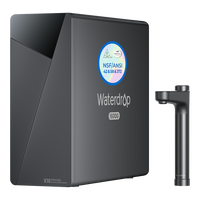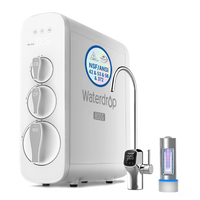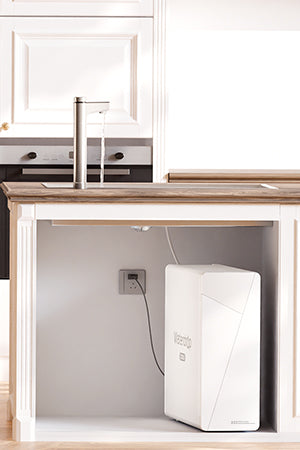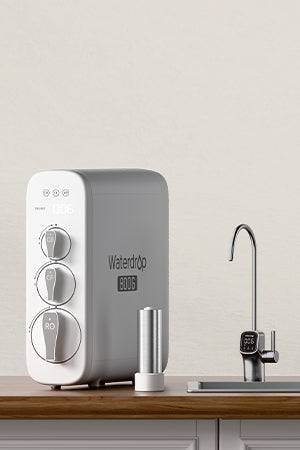Do you know that an average home uses about
80-100 gallons of water per day to accomplish indoor tasks, such as taking showers and flushing the
toilet? However,
29% of the world's population
lives off contaminated water. Such water causes more deaths in a year than wars and violent crimes combined.
Every
two minutes, a child
dies of a disease caused by ingesting unclean water.
What the numbers above show is that freshwater is vital for the health and
wellbeing of humans. Thus, homeowners who get their water from different sources often choose a water filtration
or purification system. Even though these two systems may seem interchangeable, they are different in several
fundamental ways.
This article will show the difference between water filtration and purification. It
looks at different water purification methods, such as boiling, distillation, chlorination, and filtration. We
also present various filtration methods, such as sediment filtration, reverse osmosis, and ultrafiltration.
Importance of Water Purification and Filtration
Without water, there would be no life. For instance, our bodies are
60%
water. Water is involved in several vital body functions like transmitting essential nutrients and vitamins,
flushing out toxins, regulating temperature, and lubricating the joints. It also ensures that organs of the
body, such as the skin, retain their shape.
Vital as it is for humans, some of the available water is not safe for human
consumption. It comes with contaminants. These are foreign elements present in water that adversely impact its
viability for human and animal consumption. Water contaminants may be naturally-occurring or human-made – these
include chemicals, debris, bacteria, viruses, radioactive substances, and so on.
Defining Water Purification and Water Filtration
With the contaminants in the water, it becomes crucial to either purify or filter
the water. Before we go deeper into water purification and filtration, we need to start by defining the two
processes to clear the difference between them. Even though the two processes may be different, they serve the
same purpose: to make water clean and safe to consume.
Water Filtration
The process of reducing or getting rid of solid contaminants in the water is known
as filtration. The idea behind the filtration process is that the particles of some of the contaminants are
bigger than those of water. Therefore, creating a semipermeable membrane would allow the desirable water
particles to pass while preventing the larger undesirable particles.
It is important to note that the dissolved particles in the water, which are
smaller or the same size as the water particles, will pass through the semipermeable membrane. This implies that
the filtration process alone may not be able to get rid of all the impurities. This is why modern water
filtration systems have been made sophisticated enough to ensure that as few impurities as possible can pass
through the semipermeable membrane.
Water Purification
For water to be safe to drink and meet other standards imposed by authorities, the
concentration of suspended matter and impurities must be reduced. These impurities include parasites, fungi,
bacteria, viruses, algae, and other unwanted biological or chemical contaminants. Water purification seeks to
remove undesired chemical compounds, biological contaminants, and organic and inorganic materials using various
methods. Water filtration is one of these methods.
Water Purification vs. Filtration: What’s the Difference?
From the definitions above, we can note that even though people use water
filtration and water purification interchangeably, the two processes are different. Water filtration uses
different methods to separate impurities from the water so that the water you eventually use does not have
contaminants. It is a method of cleaning water by separating the impurities from the water using a filter.
On the other hand, water purification attempts to remove all the impurities removed
by the filtration process while eliminating undesirable minerals from the water. This method is not restricted
to using a filter to separate the impurities. It may also involve the use of chemicals or separating water
particles from the impurities through chemical reactions.
Purification removes more impurities than filtration so that the water meets a
given standard. However, advances in technology are making water filters more sophisticated. They are now able
to clean the water to the standard achieved by purification.
The differences between filtration and purification can mainly be seen in the
techniques that each uses. However, even though we refer to differences between water filtration and water
purification, the technics are not mutually exclusive. This means that a purification method can also use some
filtration techniques and vice-versa.
Water Purification vs. Filtration: What’s the Difference?
Over time, water filtration methods have been getting more accessible,
sophisticated, and easier to use from anywhere. Below, we look at some of the standard methods of cleaning water
through the process of filtration.
Sediment Filtration
Sediment filtration is a method used to separate solid particles from the water. It
is the most popular home-based water filtration system. The sediment filtration material is called a sediment
filter. It is usually made from polypropylene or pleated polyester with
micron
ratings that range from 1 to 100.
Activated Carbon
Carbon removes the contaminants in the water by chemically attaching to the water.
Activated carbon filters come in different types. Some basic ones remove the chlorine from the water to improve
taste and get rid of the odor. Others are more sophisticated and remove harmful contaminants found in the water,
like metals. However, carbon filters do not remove organic pollutants in the water.
Reverse Osmosis
One of the most commonly used water filtration methods is
reverse
osmosis. In this method, water passes through a semipermeable membrane that allows the water to pass
while preventing the impurities. Because this method offers the finest level of filtration, it is commonly used
in environments like hospitals.
Usually, a reverse osmosis system is placed under the sink. Water coming from the
main supply passes through the filter before it comes out of the tap. This method does not remove metals,
solvents, and pesticides. Also, the fact that the water has to go through several stages can render the method
more expensive.
Ultrafiltration
The ultrafiltration (UF) method uses pressure to move a fluid through an extremely
fine semipermeable membrane (in most cases, 0.01 to 0.5 microns). This makes the filter able to get rid of
microscopic contaminants, such as bacteria and parasites. The main advantage of this method is that it retains
essential minerals in the water.
The UF method's main disadvantage is that it cannot remove the solids dissolved in
the water. This is why the method is often used in conjunction with other methods like reverse osmosis and
activated carbon.
Water Purification Methods
There are several water purification methods, some of which share similarities with
filtration methods:
Boiling
Boiling is a cheap and easy way to purify water. The boiling process kills
parasites, germs, and bacteria. Even though the general advice has been to let the water boil for up to five
minutes, some
recent
studies show that just getting the water to boiling point is enough.
The main advantage of boiling as a purifying water method is that it is inexpensive
and can be done anywhere as long as you have a heat source. Also, boiled water can kill most microorganisms.
While boiling may be the only choice when there are no other means of purifying
water, the method does not totally eliminate contaminants. For instance, it cannot eliminate the nitrates used
in fertilizers that can enter the water system and other undesirable minerals like mercury and lead found in
underground natural deposits.
Filtration
Filtration involves physically separating water from contaminants. It is perhaps
the most prevalent purification method, and water filters are easy to acquire at home.
The efficacy of a water filter depends on the
size of its pores, measured
in microns. The standard pore size of a good-enough filter is 0.2 microns. To set up a filtration system,
charcoal and activated carbon are arranged in cylindrical or round blocks. As the water goes through the carbon,
the contaminants and chemicals are absorbed by the carbon, allowing clean water to go through.
The filtration process removes impurities like metals, sediments, parasites, and
bacteria. Filtration is a quick process and does not alter the taste of the water.
Distillation
Distillation dates as far back as the time of the Ancient Greeks in
AD 200. This is probably
the most effective method of cleaning water because when water is turned into steam by boiling, the impurities
are left behind.
The distillation process requires a heat source, containers for boiling the water
and collecting the condensed steam, and a tube for the vapor to pass through. While the distilled water is free
from contaminants, the distillation process may also destroy the water's essential minerals.
Chlorination
Chlorination is a method that has been
used for over a century to
disinfect water. This purification method removes viruses and bacteria. Because it kills undesirable
microorganisms in water, this is a method that works well when combined with filtration.
For chlorine to be effective, it has to be in the water for some time before the
water is used. Also, the dosages have to be managed, with lower dosages taking more time to clean the water.
With regards to the safe levels of chlorine in drinking water, the
Centers for Disease Control
and Preventionh advises that “chlorine levels up to 4 milligrams per liter (mg/L or 4 parts per million
(ppm)) are
considered safe in
drinking water.”
Iodine Addition
Iodine kills bacteria and viruses easily but may leave your water with an
unpleasant taste. It is a powerful substance and should only be used sparingly. Iodine, used in
carefully-measured quantities (two drops per quart of water) and allowed to stand for 30 minutes, is deadly to
most biological water contaminants.









































































